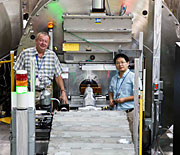- Number 345 |
- September 5, 2011
Energy and environmental solutions under our feet

Yuri Melnichenko (left) and
Lilin He at the General-Purpose
Small-Angle Neutron Scattering
Diffractometer at ORNL’s
High Flux Isotope Reactor.
When you heat water in a kettle, you can make tea or coffee. But what happens if the vessel is sealed? Ultimately, at a temperature called the liquid-gas critical point, the density of the liquid and the vapor become identical: There is no more water, there is no more gas. What you have is a supercritical fluid.
The next natural question was, "how does this coexistence of bulk fluids (water in a kettle is a bulk system) near their critical points change if you confine the whole system in a very small space, such as a small pore, say, in coal?" Neutron scientists at DOE's Oak Ridge National Laboratory, using neutron scattering instruments at the High Flux Isotope Reactor and the Spallation Neutron Source, are investigating supercritical fluids because they be a key to both storing atmospheric carbon and extracting methane from coal.
[Bill Cabage, 865.574-4399,
cabagewh@ornl.gov]
